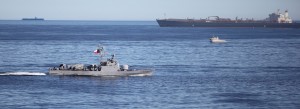Across every sector of society, decision-makers are struggling with the complexity and speed of change in an increasingly interdependent world where safety, security, regulatory, environmental, political and economic interests and considerations converge. There is probably no more complicated environment than the maritime domain, a vast and constantly changing environment, beautiful yet deadly violent, resource-rich yet fragile and ripe for exploitation, and absolutely vital to the global economy and the daily lives of billions.
Both Canada and the United States acknowledge that perimeter security is a strategic imperative to enhancing our shared security interests and accelerating the legitimate flow of people, goods and services between our two nations.
Maritime Domain Awareness is a key enabler to perimeter security and is generally described as “the effective understanding of anything associated with the maritime domain that could impact the security, safety, economy or environment” – activities, infrastructure, people, cargo, vessels or other conveyances on, under, related to, adjacent to, or bordering the sea.
Skeptics might argue that navies, coast guards, regulatory and law enforcement agencies of the world have always “done” maritime domain awareness to support their respective safety, law-enforcement and defence mandates. This is a tired argument, since the scale of achieving maritime security in the 21st century has dramatically expanded. Massive amounts of data, on all aspects of maritime activity, must be collected, correlated across sources, and analyzed to detect anomalies that may indicate vulnerabilities or threats to our maritime interests.
To complicate matters, the maritime environment cannot be looked at in isolation, and is very much connected to the aerospace, land and cyber domains.
Against the backdrop of the 9/11 attacks and acknowledging that Canada and the U.S. are maritime nations connected to the world via an increasingly complex and potentially vulnerable intermodal global supply chain, North American Aerospace Defence Command (NORAD) evolved to look at a broader spectrum of threats and, in 2006, the two governments renewed the Agreement to include the Maritime Warning Mission.
NORAD’s Maritime Warning Mission has three main components. First, information sharing which consists of processing, assessing, and disseminating intelligence and information related to the respective maritime areas and internal waterways of, and the maritime approaches to, the United States and Canada. Second, developing a comprehensive shared understanding of maritime activities to better identify potential maritime threats to North American security. And third, when information or intelligence raises a red flag, NORAD issues an advisory to alert national decision-makers, or, in the event of a confirmed threat, a maritime warning.
So what does NORAD bring to the table? First and foremost, NORAD brings a tried and tested 55-year tradition of Canadians and Americans working side by side every hour of every day to defend our bi-national security and defence interests. Relationships are key and, over the decades, NORAD has matured relationships with global allies, national and regional-level mission partners from the defence, law-enforcement, safety, and regulatory communities, and private sector stakeholders with whom we share a rich tradition of collaboration and mutual support.
With the rapidly changing pace of innovation and the fielding of new technologies, procedures and processes, through a “system of systems” approach, NORAD and its partners are now able to acquire, analyze and disseminate in real- or near-real time information about what is happening in the global maritime domain and, more importantly, rapidly transform information into a highly refined level of decision-quality understanding. The system works, and thankfully the requirement to warn national decision-makers is a fairly rare occurrence. During the past 18 months, NORAD has issued just seven advisories and two warnings, none of which can be described because the details are classified.
More than a decade after 9/11 and seven years into the Maritime Warning Mission, NORAD continues to adapt in order to deliver the capabilities it will need to confront emerging challenges and threats in the decades ahead. Events such as the Deepwater Horizon oil spill, the Fukushima earthquake and Tsunami, the groundings of the M/V Clipper Adventurer in the Canadian Arctic and the Royal Dutch Shell oil rig Kulluk off Alaska, the sinking of the Republic of Korea Ship Cheonan by North Korean Forces, and piracy in the Gulf of Guinea and Horn of Africa remind us that an “all-hazards” approach to information sharing is required.
For more than half a century, NORAD has contributed to the protection of North America and will continue to seize opportunities, outpace all threats and remain the partner of choice with defence and security stakeholders. In the 21st century global economic and security environment, collaboration is indeed a strategic imperative.
Captain Kurt N. Salchert, Royal Canadian Navy, is the Canadian Liaison Officer at the NORAD Washington Office.

